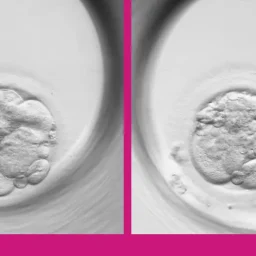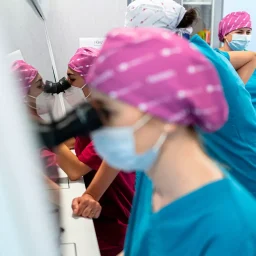
Temperature, humidity and clean air flow are fundamental aspects in In Vitro Fertilisation laboratories. These parameters must be thoroughly analysed to ensure the viability of gametes and embryos. On the occasion of the World Day of Science in the Laboratory, we will see in this blog the protocols that exist to do science in complete safety.
Assisted reproduction laboratories are controlled environment rooms. That is to say, their environment is controlled. The purpose of this control is that we do not have unwanted substances in the air, or particles that negatively affect embryo growth or contamination. This will increase the probability of achieving the birth of a healthy child, which is the main objective of assisted reproduction.
To achieve this, an attempt is made to maintain certain parameters. These may be temperature, relative humidity or differential pressure, within a constant range, making variations as small as possible.
Why is temperature so important in IVF laboratories?
It is essential to keep the temperature within certain limits, avoiding variation in the limits that would cause an abrupt change in the temperature of the culture media in which the gametes and embryos are found. These changes are minimised by the presence of culture oil on the plates, as this creates a protective layer, but if the temperature difference is high, the temperature drop graph in the drop will have a steeper curve, i.e. the drop will be more rapid.
If the temperature within the range is close to the upper limit, the incubator-environment temperature variation will be minimised, but the growth of microorganisms will be favoured, thus increasing the consequent risk of contamination in our laboratory.
Relative humidity: Relation to dehydration or contamination
On the other hand, if the relative humidity is low, the environment is very dry. This would favour the consequent dehydration of the medium (if working without oil), as well as a possible change in the osmolarity of the medium. Therefore, the conditions of the medium will not be optimal. If the humidity is too high, the growth of micro-organisms such as fungi will be favoured, leading to fungal contamination.
Positive differential pressure and clean airflow
Finally, the differential pressure of laboratories with respect to adjacent rooms is critical, with the laboratory always being positive. This implies a constant flow of air from the inside to the outside and, therefore, air tends to be directed from clean to less clean areas. This prevents the entry of uncontrolled air.
Choice of materials, cleanliness and particle control
On the other hand, we use the selection of materials, both construction and working materials, which minimise the release into the environment of all the substances we want to avoid or even the retention of these particles. Generally speaking, what we are looking for is to know the number of particles we have in different size ranges, the amount of volatile organic compounds (VOCs), as well as the identification of those that are possible.
And finally, the presence of micro-organisms. In this case, we need to know which ones and in what quantity. The sources of release of VOCs, particles and micro-organisms are well studied. Therefore, working protocols have been developed to minimise the presence of materials or activities that increase the likelihood of their presence in the environment. This is why a selection of all the materials that form part of the laboratory is developed, a detailed choice of uniforms and soaps for washing them, as well as cleaning products, among others.
How is air managed in an IVF laboratory?
Air from outside the laboratory enters through filters. In this way, everything that we do not want to bring inside the laboratory is kept outside, because the filters prevent it from entering.
The air inside the laboratory is recirculated, making it pass through new filters so that those particles or compounds that are generated inside the laboratory are retained. This happens because not everything that is not suitable for the laboratory is what we introduce from the outside; it is also known that these substances are released by working or construction materials, computer equipment or even by the personnel who access the facilities.
Finally, the laboratory air must be refreshed five times per hour. The various regulations stipulate the number of laboratory air renewals per hour.
This is so important that devices are being developed to constantly monitor the environmental quality as well as to purify the air in the laboratory. There are devices that purify the air in the laboratory. These devices eliminate pathogens present in the air. It has been observed that the number of bacteria, viruses and fungi present is minimised, and that volatile organic compounds, odours and allergens are reduced. The use of these devices is considered to be safe and effective so there is no need to be afraid of having them in IVF laboratories as there will be no negative effects on embryo growth.
A series of devices have also been developed to facilitate the control of the environmental quality of the laboratory. This type of control allows us to know the temperature, humidity and positive pressure conditions in our laboratory at all times. These parameters must be kept within certain ranges in order for the environmental conditions to be optimal. Thanks to these devices it is easier to notice a variation in any of them and to be able to carry out the corresponding corrective measure. Being able to identify these problems as early as possible minimises the problems and risks they may cause in the laboratory environment.
It also provides us with data about the curve experienced by some gases: carbon monoxide, carbon dioxide and oxygen.
As for the particles present in the laboratory, the programme counts, based on the size of the particles, how many are present, as well as the volatile organic compounds. This is why we can have an idea of the environmental quality not only when we do the annual study carried out by an external company, but we can also consult at any time what conditions we have. In this way we can identify critical moments in the environmental quality in order to avoid working in those situations.







